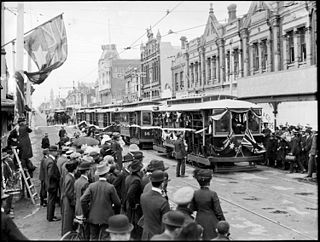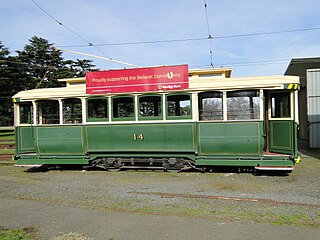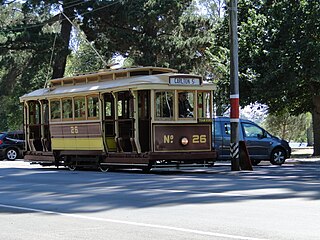Related Research Articles

Trams are a major form of public transport in Melbourne, the capital city of the state of Victoria, Australia. As of May 2017, the Melbourne tramway network consists of 250 kilometres of double track, 493 trams, 24 routes, and 1,763 tram stops. The system is the largest operational urban tram network in the world. Trams are the second most used form of public transport in overall boardings in Melbourne after the commuter railway network, with a total of 206 million passenger trips in 2017–18.

The Melbourne & Metropolitan Tramways Board (MMTB) was a government-owned authority that was responsible for the tram network in Melbourne, Australia between 1919 and 1983, when it was merged into the Metropolitan Transit Authority. It had been formed by the merger of a number of smaller tramway trusts and companies that operated throughout the city.

The Z-class are single-unit bogie trams that operate on the Melbourne tram network. Between 1975 and 1983, 230 trams spanning three sub-classes were built by Comeng, Dandenong. The design was based on two similar Gothenburg tram models, and a prototype built by the Melbourne & Metropolitan Tramways Board. While the Z1 and Z2-class trams were very similar, the Z3-class had significant design changes.

The W-class trams are a family of electric trams built by the Melbourne & Metropolitan Tramways Board (MMTB) between 1923 and 1956. Over the 33 years of production, 752 vehicles spanning 12 sub-classes were constructed, the majority at the MMTB's Preston Workshops.

The Prahran and Malvern Tramways Trust (PMTT) was a former tram operator in Melbourne, Australia. The trust was formed in 1907, with its first line operating in 1910. Its functions were taken over by the Melbourne & Metropolitan Tramways Board in 1920.
The Hawthorn Tramways Trust was a tram operator in Melbourne, Australia. Its assets and liabilities were transferred to the Melbourne & Metropolitan Tramways Board on 2 February 1920.

The Ballarat Tramway Museum is an operating tramway museum, located in Ballarat, Victoria, Australia. The museum is run by volunteers and has a fleet of trams which operate on part of the original horse tramway around Lake Wendouree and the Botanical Gardens. It has a large research collection, archive of information and more than 3,500 items about the Ballarat tramways. The trams in Ballarat operated on a large network through the city from 1887 until 1971.
Francis Richard Kirby (1911–1982) was an Australian electrical engineer and tramway administrator. After working at the State Electricity Commission of Victoria as an engineer, Kirby started working for the Melbourne and Metropolitan Tramways Board (MMTB). He became the MMTB's fourth Chairman in 1970, taking over from Robert Risson, and was succeeded by Dudley Snell, the last Chairman of the MMTB, in 1976.
North Fitzroy tram depot was a depot on the Melbourne tram network. Located on Nicholson Street, North Fitzroy, it opened in 1956 when the Melbourne & Metropolitan Tramways Board converted part of its North Fitzroy bus depot for tramway operation when the Bourke Street to Brunswick East line reopened. In 1976 it became a sub-unit of East Preston depot. It was the smallest tram depot in Melbourne.

The J-class was a class of twenty trams built by the Meadowbank Manufacturing Company, Sydney for the Prahran & Malvern Tramways Trust (PMTT). All passed to the Melbourne & Metropolitan Tramways Board on 2 February 1920 when it took over the PMTT becoming the J-class retaining their running numbers.
The L-class was a class of six trams ordered from James Moore & Sons by the Prahran & Malvern Tramways Trust (PMTT). However by the time they were delivered in 1921, the PMTT had been taken over by the Melbourne & Metropolitan Tramways Board (MMTB).

The M-class was a class of 17 trams built by Duncan & Fraser, Adelaide for the Hawthorn Tramways Trust (HTT) as numbers 1 to 10, and 33 to 39. All passed to the Melbourne & Metropolitan Tramways Board on 2 February 1920 when it took over the Municipal Tramway Trusts, becoming the M-class and being renumbered 107 to 116, and 183 to 189.
The O-class Melbourne tram were a group of four trams built in 1912 by Duncan & Fraser (Adelaide) for the Prahran & Malvern Tramways Trust (P&MTT) upon the recommendation of W. G. T. Goodman, Chief Engineer and General manager of the Adelaide tramways. They were allocated P&MTT fleet numbers 21 to 24. At the time of their introduction, they were by far the largest street-vehicles in Melbourne, and earned the nicknames Zeppelins and Dreadnoughts. Proving to be less than satisfactory in service, they were later sold to the Hawthorn Tramways Trust (HTT) in August 1916 as "surplus to requirements", however P&MTT soon ordered replacement tramcars. Coincidentally they retained their fleet numbers whilst at Hawthorn.

The P-class was a class of eight trams built by Duncan & Fraser, Adelaide for the Hawthorn Tramway Trust (HTT) as numbers 25 to 32. All passed to the Melbourne & Metropolitan Tramways Board on 2 February 1920 when it took over the HTT becoming the P-class and being renumbered 131 to 138.
The S-class was a class of 18 trams built by Duncan & Fraser, Adelaide for the Melbourne, Brunswick & Coburg Tramway Trust (MBCTT). The first 12 entered service numbered 1-12. All passed to the Melbourne & Metropolitan Tramways Board (MMTB) on 2 February 1920 when it took over the MBCTT becoming the S-class and renumbered 154-165. The other six were delivered directly to the MMTB as 166-171.
The X-class was a class of two Birney trams imported from United States manufacturers JG Brill Company and St Louis Car Company by the Melbourne & Metropolitan Tramways Board. In June 1924 both entered service from Hawthorn depot on the Power Street to Hawthorn Bridge service. In 1928 both were transferred to Glenhuntly depot to operate the Point Ormond route.
The X1-class was a class of ten trams built by the Melbourne & Metropolitan Tramways Board. Developed from the X-class, they differed in having four doors. They were initially allocated to Glenhuntly and Hawthorn depots. Six were transferred to the isolated Footscray network In June 1928 with the other four following in June 1929.
The Y-class was a one-member tram class built by the Melbourne & Metropolitan Tramways Board. It entered service in September 1927 initially operating a 24-mile tourist service, before being used on regular services on the Burwood line and all night services from Camberwell depot in company with the Y1-class.
The Y1-class was a class of four trams built by the Melbourne & Metropolitan Tramways Board built as a modified version of the Y-class to trial one man operation. Initially used on East and West Preston routes from Collins Street, from 1934 they were transferred to the Toorak line. From 1936 they were used on Burwood services from Camberwell depot. In 1933, 613 was used on Victorian Railways' Sandringham railway station to Black Rock line.
The Melbourne tram network began in 1884 with the construction of the Fairfield Horse Tramway. However, the purpose of the line was to increase land prices in the area, and it soon closed during the depression in 1890. The first genuine attempt to construct a tramway network was the construction of the Richmond cable tram line by the Melbourne Tramway & Omnibus Company in 1885. Over the next few years, 16 more cable tram lines were constructed, as well as numerous other horse tramways. The depression of the early 1890s slowed further expansion of the cable network. The first electric tram line was the Box Hill and Doncaster tramway which opened in 1889. This was a pioneering line in what was then the countryside and thus didn't receive much patronage. It closed in 1896. The next attempt at an electric tramway was Victorian Railways' St Kilda to Brighton line, which opened in 1906. Later that year, the North Melbourne Electric Tramway & Lighting Company opened lines to Essendon and Maribyrnong. Many local councils formed their own tramway trusts and built tramways within their own constituency. The most successful of these was the Prahran & Malvern Tramways Trust.
References
- ↑ "60 Years of the M&MTB" Trolley Wire issue 186 February 1980 page 14
- 1 2 Cross, Norman; Budd, Dale; Wilson, Randall (1993). Destination City Melbourne's Electric Trams (5 ed.). Sydney: Transit Publishing Australia. p. 30. ISBN 0 909459 18 5.
- ↑ X2 Class Vicsig
- ↑ Melbourne & Metropolitan Tramways Board X2 Class No 676 Hawthorn Tram Depot
- ↑ X2 Class 680 Tramway Museum Society of Victoria